Reviews and recommendations are unbiased and products are independently selected. Postmedia may earn an affiliate commission from purchases made through links on this page.
Anthony Gismondi: Oliver’s District Wine Village is moving full speed ahead

Born during the height of the COVID-19 pandemic, the District Wine Village already has 13 wineries and a brewer
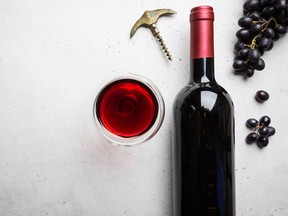
Article content
If you haven’t made your way to District Wine Village in north Oliver, make sure it is on your list the next time you are in the south Okanagan.
Advertisement 2
Article content
You will find the village on the westside of the Osoyoos Indian Band’s Senkulmen Business Park just off Highway 97, about a kilometre south of Gallagher Lake and some seven kilometres north of downtown Oliver.
You could be forgiven for not noticing the village from the highway. The unusual building circle focuses on the inside of the development, not the exterior, so look for signs directing you into the property. Appropriately its northwest backdrop is none other than the impressive McIntyre Bluff, whose spectacularly gouged granitic gneiss and quartz veins tell the story of glaciers and geological events of another time that shaped today’s Okanagan more than 12,000 years ago.
Childhood friends Max Brock and Matt Kenyon were the dreamers behind the innovative project, but Brock died unexpectedly before they could break ground. After considerable debate, the decision was made to complete the project. At that point, Kenyon, a longtime local builder, teamed up with Mike Daley, a former Arterra wine executive. Together, they brought the village to fruition during the height of the pandemic.
Advertisement 3
Article content
Building a cluster of wineries in one spot is hardly new to the wine business, but often it is a commercial production venture not intended for the public.
The District Wine Village was conceived on several levels. First, it was meant to offer a more affordable path to the wine business, giving the less than super-wealthy entry to the business at a relatively low cost. The quick startup allows tenants to start earning income much sooner than traditional land-based wineries. Each vendor has a licence, production area, and retail/tasting space. Designers have thought of everything, including hookups at the back of the building to accommodate mobile bottlers for on-site product bottling.
The buildings differ in exterior design and cladding, giving visitors an authentic if modern-village feel. Each has a large patio with high-top tables and chairs for additional outdoor service areas, all recently covered with heat reflective sails. Then there is the casual, relaxing vibe. It is the first thing you notice as you enter the circular amphitheatre that sits three steps below the ring of wineries and shops. Here visitors are entertained by local artists while they stop for lunch or snack between tastings.
Advertisement 4
Article content
Post-pandemic, the social options in the village are growing daily, featuring concerts, a weekly public market, art exhibits, a winery dinner series and more.
The focus is local, including a free Wednesday Market that runs through Sept. 14 from 4 to 7 p.m. supporting local Okanagan artists, growers, crafters and culinary artisans. A brewery is already in place and open, as is a casual restaurant. Last month a distillery was in full installation mode and should be ready to go before the summer.
As for the producers — the list is now 13 wineries long, plus Trading Post Brewing. The wineries are a collection of newbies and wineries with a brand, but no home, including Winemaker’s Cut, One Faith Vineyards, Vintners Cove Winery, Gneiss Wines, JoiRyde Winery, Wapiti Cellars and Canter Cellars. Those looking for wider exposure along Highway 97 include Eau Vivre, Valley Commons, Time Family of Wines, NK’Mip Cellars, and Silhouette Cellars.
Advertisement 5
Article content
Beer is made at Trading Post Brewing, while the Trading Post restaurant supports seasonal ingredients from local farmers, foragers, cheesemakers, and other artisanal suppliers.
The plans continue with building an educational tasting facility for resident producers and, down the road, an institution of higher learning to establish a home for practical viticulture and winemaking training. Finally, it is full speed ahead on installing an ice rink on the amphitheatre floor, scheduled to come to life this winter as the village prepares to open 365 days a year for locals and visitors alike.
Weekend wine picks
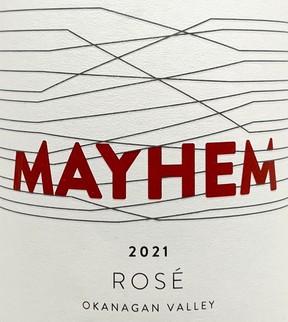
Mayhem Rosé 2021, Osoyoos, Okanagan Valley, British Columbia, Canada
$19.13 I 88/100
UPC: 626990352570
Advertisement 6
Article content
The folks at Mayhem are all about fun, and the 2021 pink delivers despite a challenging growing season across the South Okanagan. It is 100 per cent Merlot-based destemmed and crushed directly to the press. The extended cold final fermentation mix was 80/11/9 stainless-steel tank, neutral French oak barriques and stainless steel barrique. The colour is pale; the nose is a mix of red berries and sagebrush flecked with subtle orange notes that finish bone dry. Think charcuterie, olive tapenade, grilled vegetables or salmon sashimi.
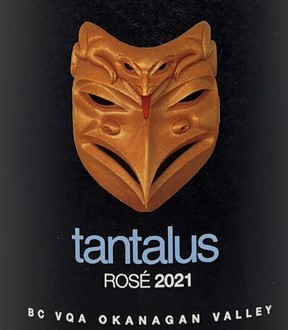
Tantalus Rosé 2021, Okanagan Valley, British Columbia, Canada
$23.48 I 90/100
UPC: 626990067382
Fresh, juicy, lively style with a touch more colour than pale, this is an impressive style of rosé that you want to drink with food. The attack is bright and vibrant with a savoury blood orange undertone supporting citrus peel and wild berries, with a saline, stony mineral undertone. An excellent balance of fruity and savoury flavours makes this wine a delight any time of the week. The blend is a 65/35 mix of Pinot Noir and Pinot Meunier. Seriously good.
Advertisement 7
Article content
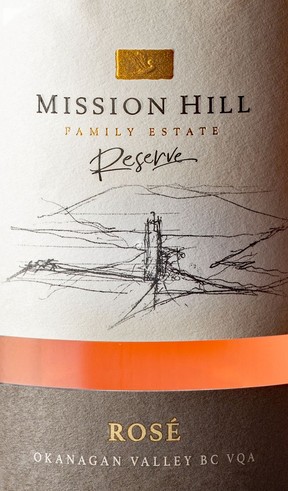
Mission Hill Reserve Rosé 2021, Okanagan Valley, British Columbia, Canada
$25 I 89/100
UPC: 776545993069
2021 Reserve Rosé grows on estate sites in Osoyoos and Oliver, first planted in 1997. The colour is barely visible, and the nose a subtle rush of watermelon and ripe raspberries. It’s bright, light elegant and simply fun to drink. Best of all, it is fresh and crisp and finished dry. It is made for food such as tapas-like bites. This year, the blend has flipped around to 56 per cent Pinot Noir, 23 per cent Merlot, and 21 per cent Syrah fermented in stainless steel. Good value too. Unprecedented midsummer heat led to the earliest start of harvest and the highest number of growing degree days on record.
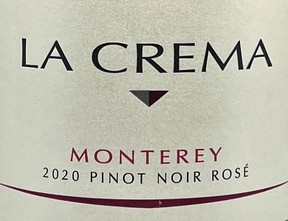
La Crema Monterey Pinot Noir Rosé 2020, Monterey County, California, United States
Advertisement 8
Article content
$28.99 I 88/100
UPC: 049331816126
Monterey’s windy, cool-climate has fingerprints all over this picture-perfect pink. The nose offers subtle aromatics of strawberries and watermelon. The fruit remains cool and muted on the palate with pink grapefruit and mandarin that persist lightly through the finish. Serve chilled with young goat cheese, smoked sausage, and a fruit compote. Bring on summer.
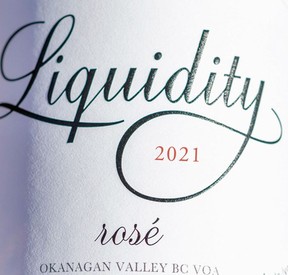
Liquidity Rosé 2021, Okanagan Falls, Okanagan Valley, British Columbia, Canada
$30 I 91/100
UPC: 626990442653
The fruit is grown and picked specifically for rosé to get that juicy acidity and freshness balanced by the perfect level of ripeness. It is all hand-sorted and whole-cluster-pressed with short skin contact time. The result is a mouth-watering, almost dry citrus affair of ruby red grapefruit and delicate wild strawberries. Winery chef Phil Tees suggests pairings of Ahi sashimi or a summer berry and spinach salad. A significant upgrade over 2020 — stock up.
Advertisement 9
Article content
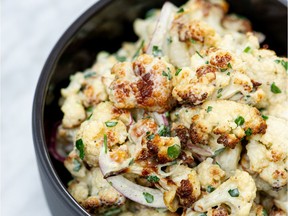
Recipe match: Roasted cauliflower and chickpea salad
Created by Jenny Hui, executive chef of The Lazy Gourmet, this vegan-friendly recipe is full of vegetables and fibre-packed chickpeas. It’s the perfect lunchtime or dinner powerhouse salad — no extra dishes required.
Or, enjoy this flavourful salad with a few other favourite salads and mains for a family style meal:
2 medium cauliflower, cut into bite-size florets
3 tbsp (45 mL) olive oil
1 cup (250 mL) chickpeas
1/2 tsp (2.5 mL) smoked paprika
1 tbsp (15 mL) olive oil
4 tbsp (60 mL) apple cider vinegar
1/4 piece red onion, julienned
1/2 cup (125 mL) mayonnaise
2 tbsp (30 mL) apple cider vinegar
1 tbsp (15 mL) sugar
1/4 cup (60 mL) chopped herbs such as dill, Italian parsley and cilantro
Advertisement 10
Article content
Preheat oven to 425 F. Line two sheet pans with parchment paper. Set aside. Place cauliflower florets and 3 tbsp olive oil in a bowl.
Season with salt and pepper. Toss, until cauliflower is coated with the oil. Transfer to one of the lined sheet pans. Place cauliflower into oven. Roast until tender and golden brown, about 20-25 minutes. Remove and toss with 4 tbsp of apple cider vinegar.
Set aside and cool.
Place chickpeas in a bowl. Add smoked paprika and 1 tbsp olive oil. Season with salt and pepper. Toss until chickpeas are coated. Transfer to the second lined sheet pan. Place chickpea in oven and roast for 15-20 minutes. Remove and cool.
In a small bowl, whisk together mayonnaise, apple cider vinegar, sugar and the herbs. Season with salt and pepper. Set aside.
Advertisement 11
Article content
In a medium bowl, place roasted cauliflower, chickpeas, julienned red onion and dressing. Toss to combine. Season again if desired.
Yields 4 servings.
Recipe match
A healthy roasted cauliflower and chickpea salad needs nothing but a touch of colour.
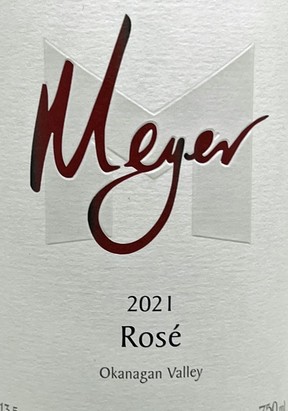
Meyer Rosé 2021, Okanagan Falls, Okanagan Valley, British Columbia, Canada ($20)
A serious and savoury dark cherry, plum yogurt, smoked stone affair that elevates any dish to a new level.

Da Silva Cor de Rosa Rosé 2020, Okanagan Valley, British Columbia, Canada ($26)
Ripe strawberry with a fresh citrus undercurrent flecked by watermelon and rhubarb. A stylish version of rosé conceived for food.
More news, fewer ads: Our in-depth journalism is possible thanks to the support of our subscribers. For just $3.50 per week, you can get unlimited, ad-lite access to The Vancouver Sun, The Province, National Post and 13 other Canadian news sites. Support us by subscribing today: The Vancouver Sun | The Province.
Source: vancouversun.com


